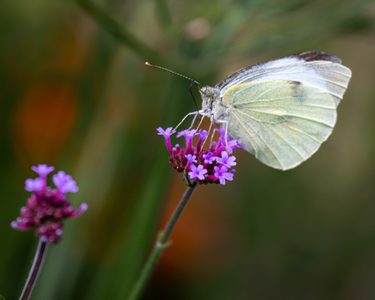Don't overlook your white butterflies

It happens every year. There you are, thinning your newly emerged brassica seedlings, and congratulating yourself on their vibrant, healthy appearance. Then out of the corner of your eye you spot the first white butterfly of the year flouncing lazily along, eying up your little green babies.
But which white? At this time of year, you might have up to six species of native white butterflies in your garden. And only two of these – large and small white respectively - enjoy eating domesticated cabbage.
They all have important part to play in our gardens and countryside as pollinators, and provide a valuable food source for invertebrates, bats and birds.
How to spot the right whites
One of the earliest white butterflies to emerge in spring will be the Green Veined White, which loves lush vegetation in damper sites. This species is easy to differentiate by flight once you’re accustomed to it. Slightly smaller than a large white, they flitter and flutter, rarely venturing above head height and frequently dropping onto flowers.
Once settled, they’re slow to take off and conveniently rest with wings folded to show off their dark vein patterns on the underside (only really greenish in freshy emerged insects.) Like small whites, they have dark corners at the top of their upper wing: sometimes a couple of smaller dark dots too. In the last 10 years, this butterfly has dramatically increased in numbers. They feed on wild members of the Brassica group such as lady’s smock, garlic mustard and watercress.
Quite different in flight is the female Brimstone. This isn’t that white - the before shot in a soap powder commercial – but is a fetching shade of lemon cream. This can vary quite a bit in individuals, some being more custard, others the lightest lemon souffle shade. The wingtips have an angelic point and are almost spotless bar a couple of central reddish-brown freckles, and the veins aren’t as clearly defined. Flight is rapid, erratic and waist level or above: brimstones rarely settle except for a few moments to lay their eggs or grab a quick snack.
You might see a Marbled White in high summer too. This is a butterfly literally on the up, both northwards and in numbers. It’s increasingly spotted in gardens and is unmistakable for its checkerboard black and white colours with a rapid wing movement. They rarely stop once the sun’s up and are annoyingly skittish for photographers. A grass feeder, found on chalk or limestone soils, enjoy them while they’re about, as the flight season is short - barely two months.
The ones that like your cabbages
The infamous large and small whites are some of the most common whites you’ll see in your garden.
The small white is, indeed, smaller, producing the green caterpillars that burrow into cabbages, or hug the central vein of the inner leaves. Small whites flap around in a busy, directed way and bounce up, Tigger-like, as soon as they sense movement. Wings are greyish rather than pure white, with sooty marks at the top corners and dark spots on the hind wings. Although the underside of the hind wings may be yellowish, especially in summer generations, the veins don’t stand out as strongly as a green veined white.
Large white butterflies have pure white, powerful wings with black, not greyish edges, which extend down the sides, and two large black spots on the female’s forewings. Like the small white, the hindwings can have a yellowish tint underneath. Large white flight is direct, determined and higher up than the small white.
It’s the large whites that are the parents of the dreaded yellow and black cabbage caterpillars, and they can have multiple generations from May to June, and July to September. (We have recorded late-stage larvae in January at our organic demonstration garden in Ryton, near Coventry.) And at the height of the season, they can wreak havoc. Small plants will be eaten alive, and larger plants severely damaged with leaves contaminated with excrement.

How to tackle cabbage caterpillars
A pesticide-free vegetable garden bursting with flowers and flowering herbs will supply nectar for natural predators such as parasitic wasps and ladybirds. Cabbage whites are also partial to nasturtium so this can sometimes be a good sacrificial plant to sow next to your brassicas – but it doesn’t always work.
Checking leaf undersides regularly for eggs, and removing by hand, can help limit infestations. You can also use fine eco-mesh netting to prevent the butterflies from laying. Make sure it’s tall enough!
And try not to worry about browning leaves. A 2027 study found browning leaves from caterpillar damage was actually a plant defence mechanism. Eggs need humidity to hatch and a food source (succulent fresh leaves) for the emerging caterpillars. A dry, dead leaf reduces the likelihood of the eggs surviving and hatching.
While they may not be as white as the driven snow, white butterflies – and their more colourful cousins - are still incredible pollinators and well worth welcoming into your garden. Being super-sensitive to habitat and climate change, butterflies are also a great indicator of a healthy environment. A garden that attracts butterflies will also bring bees and birds and much more.